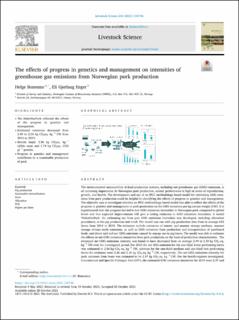| dc.description.abstract | The environmental sustainability of food production systems, including net greenhouse gas (GHG) emissions, is of increasing importance. In Norwegian pork production, animal performance is high in terms of reproduction, growth, and health. The development and use of an IPCC methodology-based model for estimating GHG emissions from pork production could be helpful in identifying the effects of progress in genetics and management. The objective was to investigate whether an IPCC methodology-based model was able to reflect the effects of the progress in genetics and management in pork production on the GHG emissions per kg carcass weight (CW). It is hypothesized that this progress has led to low GHG emissions intensities in Norwegian pork compared to global levels and that expected improvements will give a lasting reduction in GHG emissions intensities. A model ‘HolosNorPork’ for estimating net farm gate GHG emissions intensities was developed, including allocation procedures, at the pig production unit level. The model was run with pig production data from in average 632 farms from 2014 to 2019. The estimates include emissions of enteric and manure storage methane, manure storage nitrous oxide emissions, as well as GHG emissions from production and transportation of purchased feeds, and direct and indirect GHG emissions caused by energy use in pig-barns. The model was able to estimate the effects on net GHG emissions intensities from pork production on the basis of production characteristics. The estimated net GHG emissions intensity was found to have decreased from on average 2.49 to 2.34 kg CO2 eq. kg−1 CW over the investigated period. For 2019 the net GHG emission for the one-third lower performing farms was estimated to 2.56 kg CO2 eq. kg−1 CW, whereas for the one-third medium and one-third best performing farms the estimates were 2.36 and 2.16 kg CO2 eq. kg−1 CW, respectively. The net GHG emissions intensity for pork carcasses from boars was estimated to be 2.07 kg CO2 eq. kg−1 CW. For the health regimes investigated, Conventional and Specific-Pathogen Free (SPF), the estimated GHG emissions intensities for 2019 were 2.37 and 2.24 kg CO2 eq. kg−1 CW, respectively. The effects on net GHG emissions intensities of breeding and management measures were estimated to be profound, and this progress in pig production systems contributes to an on-going strengthening of pork as a sustainable source for human food supply. | en_US |

